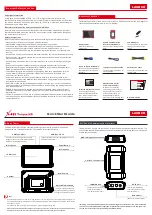
SAFETY INSTRUCTIONS
SAFETY INSTRUCTIONS
3
Center Punch Test Results
1. If the fastener point is flattened, the
material is too hard for a powder actuated
fastening.
2. If the fastener penetrates the material
easily, the material is too soft.
3. If the material cracks or shatters, the
material is too brittle.
4. If the fastener makes a small indention
into the material, the material is suitable
for fastening.
NEVER FASTEN INTO SOFT
MATERIALS SUCH AS DRYWALL
NEVER FASTEN INTO VERY HARD
OR BRITTLE MATERIALS
DANGER
DANGER
3
INSTRUCCIONES DE SEGURIDAD
PELIGRO
PELIGRO
INSTRUCCIONES DE SEGURIDAD
Preparación
Materiales base aceptables
La fijación por medio de herramientas activadas
con pólvora es solamente adecuada para usarse
en los siguientes materiales base:
• Concreto vertido
• Acero estructural
• Uniones de mampostería
(vea la página 8)
Nunca intente realizar las fijaciones en otro tipo
de material.
La fijación en otros ma
teriales puede
ocasionar ceguera u otras lesiones graves.
Materiales base inaceptables
Nunca intente realizar las fijaciones en
materiales muy duros o frágiles tales como
hierro fundido, cerámica,
vidrio, o piedra de
cualquier tipo.
Estos materiales se pueden hacer
pedazos, haciendo que los fra
gmentos del material
base o del elemento de fijación salten y ocasionen
lesiones graves al operador de la herramienta y a
terceros.
Nunca fije los elementos sobre materiales base
blandos, tales como paredes de yeso o productos
de madera.
Estos materiales pueden permitir que el
elemento de fijación los atra
viese completamente y
salga por el otro lado, poniendo en peligro a aquellos
que se encuentren en el paso del elemento de
fijación disparado.
Nunca realice las fijaciones en un material base
que no pase la prueba de Punzón de Marcar.
El
no comprobar la idoneidad del material base puede
ocasionar lesiones graves a los ojos y a otras partes
del cuerpo.
Prueba de Punzón de Marcar
USE SIEMPRE GAFAS DE SEGURID
AD CUANDO
REALICE ESTA PR
UEBA.
1. Compruebe siempre la dureza del material
que se va a fijar antes de intentar realizar la
operación de fijación.
2. Utilizando un elemento de fijación como
punzón de marcar, golpee el elemento contra
la superficie de trabajo dando un golpe
normal de martillo y vea los resultados.
Resultados de la prueba de
Punzón de Marcar
1. Si la punta del elemento de fijación se
aplasta, significa que el material es
demasiado duro para fijar por este medio.
2. Si el elemento de fijación penetra muy
fácilmente en el material base,
significa
que éste es demasiado blando.
3. Si el material se quiebra o se fragmenta,
significa que es demasiado frágil.
4. Si el elemento de fijación hace una
pequeña marca en el material, significa
que el material es adecuado para realizar
la operación de fijación.
NUNCA INTENTE REALIZAR
FIJACIONES SOBRE MATERIALES
BLANDOS TALES COMO P
AREDES DE
YESO
NUNCA INTENTE REALIZAR
FIJACIONES SOBRE MATERIALES MUY
DUROS O FRÁGILES
Preparation
Acceptable Base Materials
Powder-actuated fastening is suitable for use in
the following base materials only:
• Poured Concrete
• Structural Steel
• Masonry Joints
(see page 8)
Never attempt to fasten into any other type of
material.
Fastening into other materials can cause
blindness or other serious injury.
Unacceptable Base Materials
Never attempt to fasten into very hard or brittle
materials such as cast iron, tile, glass, or rock
of any type.
These materials can shatter, causing
the fastener and/or base material fragments to fly
free and cause serious injury to tool operator and
others.
Never fasten into soft base materials, such as
drywall or lumber products.
These materials may
allow the fastener to travel completely through and
out the other side, endangering those in the path of
the fastener.
Never fasten into any base material that does
not pass the Center Punch test.
Failure to assure
the suitability of the base material can result in
serious injury to the eyes or other body parts.
Center Punch Test
ALWAYS WEAR SAFETY GOGGLES WHEN
PERFORMING THIS TEST.
1. Always check the material being fastened
into for hardness before attempting any
fastening operation.
2. Using a fastener as a center punch, strike the
fastener against the work surface using an
average hammer blow and check the results.




































